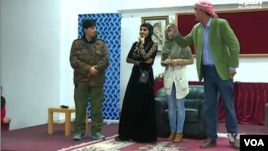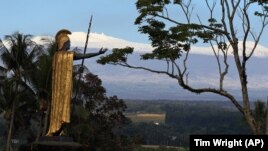15 February, 2016
Talking birds, goats butting heads, and a giant tortoise that hangs out with chickens are all part of a living classroom.
High-school students at the Career Center in Arlington, Virginia are learning firsthand, and hands-on, how to care for animals. They are at the animal science laboratory, learning about, and taking care of, about 50 species of animals.
Holding a happy rabbit in her arms, Elleny Alemu says it is "so cute." She says soon she will be getting one of her own.
Miguel Zambrano doesn't feel the same way about Snickers. That is a temperamental brown miniature horse. Zambrano is feeding her hay, hoping she will let him brush her.
"She gets mad if you just sometimes don't even pay attention to her. I do not want a horse. It's going to be way too much work."
Zambrano is one of 70 students taking the yearlong animal science program. Students learn in class and hands-on with the animals. It gives them both class credit and a chance to learn what it is like to work with animals.
Sydney Miller takes a rabbit for a walk, to give it exercise. She takes the animal on a leash, like a dog. They walk past cages of rats, salamanders and even a hedgehog.
"I wanted to learn more about different kinds of animals and get like a hands-on experience."
Something not so fun she has to do is clean the rabbit's cage. Rabbits are very dirty, actually, she explains.
"I have to clean his litter box and bedding every day."
One day, Miller hopes to be a veterinary technician.
Many high schools have animal science programs. But animal-science teacher Cindy Schall says this program is different because they have a large number of different kinds of animals. They include exotic sugar gliders -- small nocturnal marsupials with big eyes that live in Australia and Indonesia.
The students take turns every two weeks taking care of a different animal. Everything from cats to the less than human-friendly scorpions.
Schall explains that the students learn "hand taming." They have to hold them for at least 10 minutes. Yes, that includes snakes and even tarantulas — a kind of sometimes deadly spider. Schall says she helps the student, by first holding the animal herself.
Part of the care includes weighing the animals and checking them for any health problems. Sarah Maller looks into the eyes of a rodent, a degu.
"I have to see if there are any little eyelashes or anything in the way, or scratches."
Kimberly Rodriquez learned something new when she fed a turtle a small dead mouse in a tank with fish. She says she was surprised to find out the turtle eats meat, and he gets along with the fish.
Lab assistant Rebecca Brumbaugh helps the students. She says that, like people, animals have minds of their own.
"They have their good days and their bad days."
Megan Johnson wants to be a vet. She pet a chinchilla as she held it.
"The different animals have different personalities and they connect with different humans."
Ruben Stann weighs a golden-colored albino horned frog. He says he feels an emotional bond with animals.
"You have to kind of make a little connection. For me, it's very relaxing."
And connecting to the natural world is not always easy for the students living in the mostly urban Virginia towns just outside Washington, D.C.
I'm Anne Ball.
Deborah Block reported on this story for VOANews. Anne Ball adapted this story for Learning English. Kathleen Struck was the editor.
Do you have animals? What kind? We want to hear from you. Write to us in the Comments Section and on 51VOA.COM.
_
Words in This Story
tortoise –n. a turtle that lives on the land
firsthand –adj. coming directly from seeing or experiencing something
rabbit –n. a small animal that usually lived in holes in the ground, with soft fur and long ears
temperamental –adj. likely to become upset or angry
miniature – adj. very small
leash –n. long thin piece of rope or chain used to hold an animal
salamander -n. a tailed amphibian, which have a soft, moist, scaleless skin
hedgehog -n. a mammal with spiny hairs on the back and sides
veterinary technician –n. a person who helps a veterinarian, an animal doctor
exotic –adj. very different, strange or unusual
nocturnal – adj. something active at night
marsupial –n. a kind of animal, like a kangaroo, that carries its babies in a pocket of skin on the mother's stomach
scorpion –n. a small animal related to spiders, with two front claws and a curved tail with poison in the end
hand taming – n. training animals to obey people
chinchilla - n. a small South American animal that has soft gray fur
albino –adj. lacking pigment, white
urban –adj. relating to cities and people who live in them













